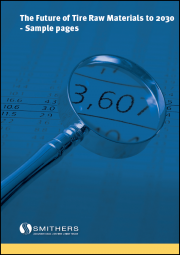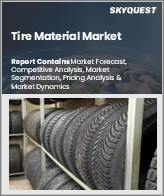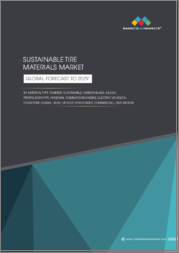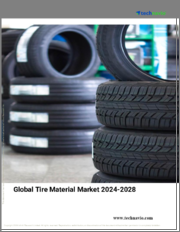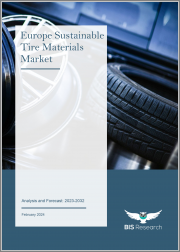
|
시장보고서
상품코드
1782755
세계의 타이어 재료 시장 조사 보고서 : 산업 분석, 규모, 점유율, 성장, 동향, 예측(2025-2033년)Global Tire Material Market Research Report- Industry Analysis, Size, Share, Growth, Trends and Forecast 2025 to 2033 |
||||||
세계의 타이어 재료 시장 규모는 2024년 1,035억 3,000만 달러에서 2033년에는 1,533억 3,000만 달러로 성장할 것으로 예측되며, 2026-2033년 예측 기간 동안 4.46%의 견조한 연평균 복합 성장률(CAGR)로 성장할 전망입니다.
타이어 재료 시장은 자동차 및 운송 부문에서 고성능 타이어 수요가 계속 증가하고 있기 때문에 큰 성장을 이루고 있습니다. 고무 화합물, 섬유, 강철과 같은 타이어 재료는 내구성, 안전성 및 성능을 갖춘 타이어를 제조하는 데 필수적입니다. 자동차 산업이 진화하고 연비 효율과 지속가능성에 대한 관심이 높아짐에 따라 타이어 재료 시장은 더욱 확대될 것으로 예측됩니다. 이 추세는 자동차 생산 및 판매가 확대되는 지역에서 특히 두드러지며, 제조업체는 고품질 타이어 솔루션을 선호합니다.
게다가 지속가능성과 친환경 사례를 강조하는 경향이 커지고 있는 것도 타이어 재료 시장에 큰 영향을 미칩니다. 소비자와 기업의 환경 의식이 높아짐에 따라 지속가능한 기술로 생산되어 타이어 생산 전체의 지속가능성에 기여하는 타이어 재료에 대한 수요가 높아지고 있습니다. 개발 제조업체는 성능 기준을 유지하면서 환경에 대한 영향을 저감하는 친환경 고무 컴파운드나 재료를 개발하는 것으로 대응하고 있습니다. 이러한 지속가능성으로의 전환은 기업이 소비자의 가치와 규제 요건과 조화를 이루는 가운데 타이어 재료 시장을 홍보할 것으로 예측됩니다.
또한 재료 과학과 기술의 발전이 타이어 재료의 능력을 향상시키고 있습니다. 고무의 배합, 보강재료, 제조 공정의 혁신은 타이어의 성능과 수명을 향상시켜 소비자에게 더욱 매력적이게 하고 있습니다. 또한 타이어 공압 모니터링 시스템(TPMS)과 고급 트레드 설계와 같은 스마트 기술의 통합으로 자동차의 기능과 안전성이 더욱 향상되었습니다. 타이어 재료 시장이 이러한 동향과 기술의 진보를 계속 받아들일수록 지속적인 성장이 예상되어 자동차 부품 산업에서 중요한 진입 기업으로서의 지위를 확고히 하고 있습니다.
당사의 보고서는 다양한 산업 및 시장에 대한 종합적이고 실용적인 인사이트를 고객에게 제공하기 위해 면밀히 작성되었습니다. 각 보고서에는 시장 상황을 완전히 이해하기 위해 몇 가지 중요한 요소가 포함되어 있습니다.
시장 개요 : 정의, 분류, 산업 현황에 대한 개요 등 시장에 대한 상세한 소개.
시장 역학 : 시장 성장에 영향을 미치는 주요 촉진요인 및 억제요인, 기회 및 과제를 상세하게 분석합니다. 이 섹션에서는 기술 발전, 규제 변경, 새로운 동향 등의 요인을 확인합니다.
세분화 분석 : 제품 유형, 용도, 최종 사용자, 지역 등의 기준에 따라 시장을 명확한 부문으로 분류합니다. 이 분석은 각 부문의 성과 및 장래를 밝혀줍니다.
경쟁 구도 : 시장 점유율, 제품 포트폴리오, 전략적 이니셔티브, 재무 실적 등 주요 시장 진출 기업의 종합적 평가. 주요 기업이 채용하는 경쟁 역학 및 주요 전략에 관한 인사이트를 기재하고 있습니다.
시장 예측 : 과거 데이터 및 현재 시장 상황에 따라 일정 기간 동안 시장 규모와 성장 동향을 예측합니다. 여기에는 정량적 분석 및 향후 시장 궤적을 보여주는 그래프 표시가 포함됩니다.
지역 분석 : 다양한 지리적 지역에서 시장 성과를 평가하고 주요 시장과 지역 동향을 파악합니다. 지역 시장 역학 및 비즈니스 기회를 이해하는 데 도움이 됩니다.
새로운 동향 및 기회 : 현재 시장 동향과 새로운 시장 동향, 기술 혁신, 잠재적인 투자 대상 부문을 파악합니다. 미래의 개발과 성장 전망에 대한 인사이트를 제공합니다.
목차
제1장 서문
제2장 주요 요약
- 시장의 하이라이트
- 세계 시장 현황
제3장 타이어 산업 분석
- 서문 : 시장 역학
- 시장 성장 촉진요인
- 시장 성장 억제요인
- 시장 기회
- 산업 동향
- Porter's Five Forces 분석
- 시장 매력 분석
제4장 밸류체인 분석
- 밸류체인 분석
- 원료 분석
- 원료 리스트
- 원료 제조업체 일람
- 주요 원료의 가격 동향
- 잠재적 구매자 목록
- 마케팅 채널
- 직접 마케팅
- 간접 마케팅
- 마케팅 채널 발전 동향
제5장 세계의 타이어 재료 시장 분석 : 차종별
- 차종별 개요
- 차종별 과거 및 예측 데이터 분석
- 승용차
- 버스
- 트럭
- LCV
제6장 세계의 타이어 재료 시장 분석 : 유형별
- 유형별 개요
- 유형별 과거 및 예측 데이터 분석
- 엘라스토머
- 강화 필러
- 가소제
- 화학제품
- 금속 보강재
- 섬유 보강재
제7장 세계의 타이어 재료 시장 분석 : 지역별
- 지역별 전망
- 서문
- 북미의 매출 분석
- 개요, 분석 및 예측
- 북미 : 부문별
- 북미 : 국가별
- 미국
- 캐나다
- 멕시코
- 유럽의 매출 분석
- 개요, 분석 및 예측
- 유럽 : 부문별
- 유럽 : 국가별
- 영국
- 프랑스
- 독일
- 이탈리아
- 러시아
- 기타 유럽
- 아시아태평양의 매출분석
- 개요, 분석 및 예측
- 아시아태평양 : 부문별
- 아시아태평양 : 국가별
- 중국
- 인도
- 일본
- 한국
- 호주
- 동남아시아
- 기타 아시아태평양
- 라틴아메리카의 매출 분석
- 개요, 분석 및 예측
- 라틴아메리카 : 부문별
- 라틴아메리카 : 국가별
- 브라질
- 아르헨티나
- 페루
- 칠레
- 기타 라틴아메리카
- 중동 및 아프리카의 매출 분석
- 개요, 분석 및 예측
- 중동 및 아프리카 : 부문별
- 중동 및 아프리카 : 국가별
- 사우디아라비아
- 아랍에미리트(UAE)
- 이스라엘
- 남아프리카
- 기타 중동 및 아프리카
제8장 타이어 재료 기업 경쟁 구도
- 타이어 재료 시장의 경쟁
- 제휴, 협력 및 협정
- 합병 및 인수
- 신제품 발매
- 기타 개발
제9장 기업 프로파일
- 주요 기업의 시장 점유율 분석
- 시장 집중도
- Lanxess
- Cabot Corporation
- Phillips Carbon Black Limited
- The Goodyear Tire And Rubber Company
- Sinopec
- Kuraray
- JSR Corporation
- Thai Carbon Black Public Company Limited(Birla Carbon)
- Orion Engineered Carbons SA
- Royal Dutch Shell
Global Tire Material Market size is anticipated to grow from USD 103.53 Billion in 2024 to USD 153.33 Billion by 2033, showcasing a robust Compound Annual Growth Rate (CAGR) of 4.46% during the forecast period of 2026 to 2033.
The tire material market is experiencing significant growth as the demand for high-performance tires continues to rise in the automotive and transportation sectors. Tire materials, including rubber compounds, textiles, and steel, are essential for producing tires that offer durability, safety, and performance. As the automotive industry evolves and the focus on fuel efficiency and sustainability increases, the market for tire materials is expected to expand further. This trend is particularly evident in regions with growing automotive production and sales, where manufacturers prioritize high-quality tire solutions.
Moreover, the growing emphasis on sustainability and eco-friendly practices is significantly influencing the tire material market. As consumers and businesses become more environmentally conscious, there is a rising demand for tire materials that are produced using sustainable practices and that contribute to the overall sustainability of tire production. Manufacturers are responding by developing eco-friendly rubber compounds and materials that reduce environmental impact while maintaining performance standards. This shift towards sustainability is expected to propel the tire material market, as companies seek to align with consumer values and regulatory requirements.
Additionally, advancements in material science and technology are enhancing the capabilities of tire materials. Innovations in rubber formulations, reinforcement materials, and manufacturing processes are improving the performance and longevity of tires, making them more appealing for consumers. Furthermore, the integration of smart technologies, such as tire pressure monitoring systems (TPMS) and advanced tread designs, is providing additional levels of functionality and safety for vehicles. As the tire material market continues to embrace these trends and technological advancements, it is expected to experience sustained growth, solidifying its position as a key player in the automotive components industry.
Our reports are meticulously crafted to provide clients with comprehensive and actionable insights into various industries and markets. Each report encompasses several critical components to ensure a thorough understanding of the market landscape:
Market Overview: A detailed introduction to the market, including definitions, classifications, and an overview of the industry's current state.
Market Dynamics: In-depth analysis of key drivers, restraints, opportunities, and challenges influencing market growth. This section examines factors such as technological advancements, regulatory changes, and emerging trends.
Segmentation Analysis: Breakdown of the market into distinct segments based on criteria like product type, application, end-user, and geography. This analysis highlights the performance and potential of each segment.
Competitive Landscape: Comprehensive assessment of major market players, including their market share, product portfolio, strategic initiatives, and financial performance. This section provides insights into the competitive dynamics and key strategies adopted by leading companies.
Market Forecast: Projections of market size and growth trends over a specified period, based on historical data and current market conditions. This includes quantitative analyses and graphical representations to illustrate future market trajectories.
Regional Analysis: Evaluation of market performance across different geographical regions, identifying key markets and regional trends. This helps in understanding regional market dynamics and opportunities.
Emerging Trends and Opportunities: Identification of current and emerging market trends, technological innovations, and potential areas for investment. This section offers insights into future market developments and growth prospects.
SEGMENTATION COVERED IN THE REPORT
By Vehicle Type
- Passenger Cars
- Buses
- Trucks
- LCV
By Type
- Elastomers
- Reinforcing Fillers
- Plasticizers
- Chemicals
- Metal Reinforcements
- Textile Reinforcements
- COMPANIES PROFILED
- Lanxess
- Cabot Corporation
- Phillips Carbon Black Limited
- The Goodyear Tire and Rubber Company
- Sinopec
- Kuraray
- JSR Corporation
- Thai Carbon Black Public Company Limited (Birla Carbon)
- Orion Engineered Carbons S.A.
- Royal Dutch Shell.
- The above list can be customized.
TABLE OF CONTENTS
1. PREFACE
- 1.1. Report Description
- 1.1.1 Objective
- 1.1.2 Target Audience
- 1.1.3 Unique Selling Proposition (USP) & offerings
- 1.2. Research Scope
- 1.3. Research Methodology
- 1.3.1 Market Research Process
- 1.3.2 Market Research Methodology
2. EXECUTIVE SUMMARY
- 2.1. Highlights of Market
- 2.2. Global Market Snapshot
3. TIRE MATERIAL INDUSTRY ANALYSIS
- 3.1. Introduction - Market Dynamics
- 3.2. Market Drivers
- 3.3. Market Restraints
- 3.4. Opportunities
- 3.5. Industry Trends
- 3.6. Porter's Five Force Analysis
- 3.7. Market Attractiveness Analysis
- 3.7.1 Market Attractiveness Analysis By Vehicle Type
- 3.7.2 Market Attractiveness Analysis By Type
- 3.7.3 Market Attractiveness Analysis By Regions
4. VALUE CHAIN ANALYSIS
- 4.1. Value Chain Analysis
- 4.2. Raw Material Analysis
- 4.2.1 List of Raw Materials
- 4.2.2 Raw Material Manufactures List
- 4.2.3 Price Trend of Key Raw Materials
- 4.3. List of Potential Buyers
- 4.4. Marketing Channel
- 4.4.1 Direct Marketing
- 4.4.2 Indirect Marketing
- 4.4.3 Marketing Channel Development Trend
5. GLOBAL TIRE MATERIAL MARKET ANALYSIS BY VEHICLE TYPE
- 5.1. Overview By Vehicle Type
- 5.2. Historical and Forecast Data Analysis By Vehicle Type
- 5.3. Passenger Cars Historic and Forecast Sales By Regions
- 5.4. Buses Historic and Forecast Sales By Regions
- 5.5. Trucks Historic and Forecast Sales By Regions
- 5.6. LCV Historic and Forecast Sales By Regions
6. GLOBAL TIRE MATERIAL MARKET ANALYSIS BY TYPE
- 6.1. Overview By Type
- 6.2. Historical and Forecast Data Analysis By Type
- 6.3. Elastomers Historic and Forecast Sales By Regions
- 6.4. Reinforcing Fillers Historic and Forecast Sales By Regions
- 6.5. Plasticizers Historic and Forecast Sales By Regions
- 6.6. Chemicals Historic and Forecast Sales By Regions
- 6.7. Metal Reinforcements Historic and Forecast Sales By Regions
- 6.8. Textile Reinforcements Historic and Forecast Sales By Regions
7. GLOBAL TIRE MATERIAL MARKET ANALYSIS BY GEOGRAPHY
- 7.1. Regional Outlook
- 7.2. Introduction
- 7.3. North America Sales Analysis
- 7.3.1 Overview, Historic and Forecast Data Sales Analysis
- 7.3.2 North America By Segment Sales Analysis
- 7.3.3 North America By Country Sales Analysis
- 7.3.4 United States Sales Analysis
- 7.3.5 Canada Sales Analysis
- 7.3.6 Mexico Sales Analysis
- 7.4. Europe Sales Analysis
- 7.4.1 Overview, Historic and Forecast Data Sales Analysis
- 7.4.2 Europe By Segment Sales Analysis
- 7.4.3 Europe By Country Sales Analysis
- 7.4.4 United Kingdom Sales Analysis
- 7.4.5 France Sales Analysis
- 7.4.6 Germany Sales Analysis
- 7.4.7 Italy Sales Analysis
- 7.4.8 Russia Sales Analysis
- 7.4.9 Rest Of Europe Sales Analysis
- 7.5. Asia Pacific Sales Analysis
- 7.5.1 Overview, Historic and Forecast Data Sales Analysis
- 7.5.2 Asia Pacific By Segment Sales Analysis
- 7.5.3 Asia Pacific By Country Sales Analysis
- 7.5.4 China Sales Analysis
- 7.5.5 India Sales Analysis
- 7.5.6 Japan Sales Analysis
- 7.5.7 South Korea Sales Analysis
- 7.5.8 Australia Sales Analysis
- 7.5.9 South East Asia Sales Analysis
- 7.5.10 Rest Of Asia Pacific Sales Analysis
- 7.6. Latin America Sales Analysis
- 7.6.1 Overview, Historic and Forecast Data Sales Analysis
- 7.6.2 Latin America By Segment Sales Analysis
- 7.6.3 Latin America By Country Sales Analysis
- 7.6.4 Brazil Sales Analysis
- 7.6.5 Argentina Sales Analysis
- 7.6.6 Peru Sales Analysis
- 7.6.7 Chile Sales Analysis
- 7.6.8 Rest of Latin America Sales Analysis
- 7.7. Middle East & Africa Sales Analysis
- 7.7.1 Overview, Historic and Forecast Data Sales Analysis
- 7.7.2 Middle East & Africa By Segment Sales Analysis
- 7.7.3 Middle East & Africa By Country Sales Analysis
- 7.7.4 Saudi Arabia Sales Analysis
- 7.7.5 UAE Sales Analysis
- 7.7.6 Israel Sales Analysis
- 7.7.7 South Africa Sales Analysis
- 7.7.8 Rest Of Middle East And Africa Sales Analysis
8. COMPETITIVE LANDSCAPE OF THE TIRE MATERIAL COMPANIES
- 8.1. Tire Material Market Competition
- 8.2. Partnership/Collaboration/Agreement
- 8.3. Merger And Acquisitions
- 8.4. New Product Launch
- 8.5. Other Developments
9. COMPANY PROFILES OF TIRE MATERIAL INDUSTRY
- 9.1. Top Companies Market Share Analysis
- 9.2. Market Concentration Rate
- 9.3. Lanxess
- 9.3.1 Company Overview
- 9.3.2 Company Revenue
- 9.3.3 Products
- 9.3.4 Recent Developments
- 9.4. Cabot Corporation
- 9.4.1 Company Overview
- 9.4.2 Company Revenue
- 9.4.3 Products
- 9.4.4 Recent Developments
- 9.5. Phillips Carbon Black Limited
- 9.5.1 Company Overview
- 9.5.2 Company Revenue
- 9.5.3 Products
- 9.5.4 Recent Developments
- 9.6. The Goodyear Tire And Rubber Company
- 9.6.1 Company Overview
- 9.6.2 Company Revenue
- 9.6.3 Products
- 9.6.4 Recent Developments
- 9.7. Sinopec
- 9.7.1 Company Overview
- 9.7.2 Company Revenue
- 9.7.3 Products
- 9.7.4 Recent Developments
- 9.8. Kuraray
- 9.8.1 Company Overview
- 9.8.2 Company Revenue
- 9.8.3 Products
- 9.8.4 Recent Developments
- 9.9. JSR Corporation
- 9.9.1 Company Overview
- 9.9.2 Company Revenue
- 9.9.3 Products
- 9.9.4 Recent Developments
- 9.10. Thai Carbon Black Public Company Limited (Birla Carbon)
- 9.10.1 Company Overview
- 9.10.2 Company Revenue
- 9.10.3 Products
- 9.10.4 Recent Developments
- 9.11. Orion Engineered Carbons S.A.
- 9.11.1 Company Overview
- 9.11.2 Company Revenue
- 9.11.3 Products
- 9.11.4 Recent Developments
- 9.12. Royal Dutch Shell
- 9.12.1 Company Overview
- 9.12.2 Company Revenue
- 9.12.3 Products
- 9.12.4 Recent Developments









